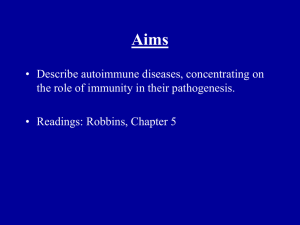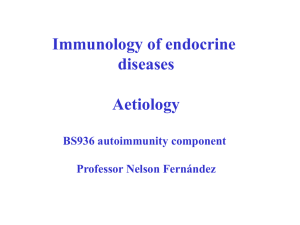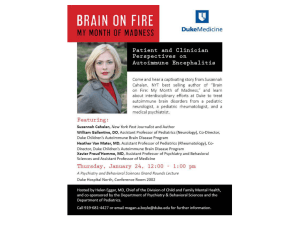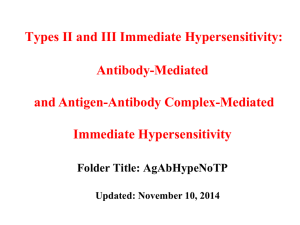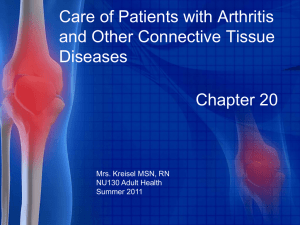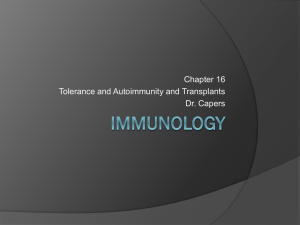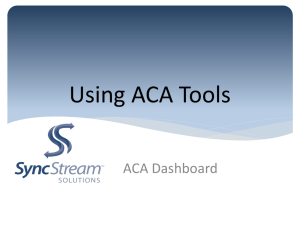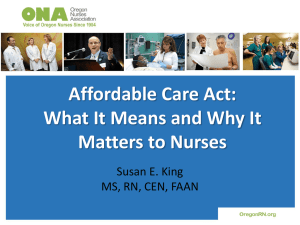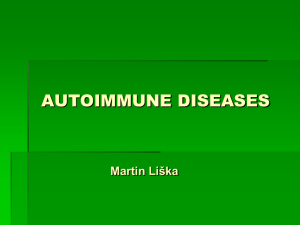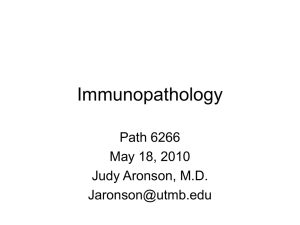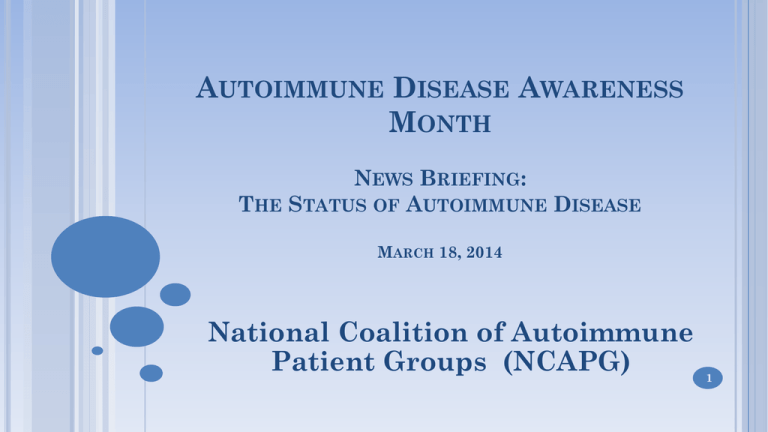
AUTOIMMUNE DISEASE AWARENESS
MONTH
NEWS BRIEFING:
THE STATUS OF AUTOIMMUNE DISEASE
MARCH 18, 2014
National Coalition of Autoimmune
Patient Groups (NCAPG)
1
AGENDA
Bob Goldberg
NCAPG, The National Coalition of Autoimmune Patient Groups
ADAM, Autoimmune Disease Awareness Month
Virginia Ladd
Stephanie Hales
The NCAPG Accountable Care Act Survey Results
Stanley Finger
What are Autoimmune Diseases?
The need for Physician Education
Aaron Abend
The Autoimmune Disease Registry
2
NATIONAL COALITION OF AUTOIMMUNE
PATIENT GROUPS (NCAPG)
3
NATIONAL COALITION OF AUTOIMMUNE PATIENT
GROUPS (NCAPG)
Mission Statement
To consolidate the voice of autoimmune
disease patients and to promote
increased education, awareness, and
research into all aspects of autoimmune
diseases through a collaborative
approach.
4
NCAPG MEMBERS
American Autoimmune Related Diseases Association
American Behçet's Disease Association
American Vitiligo Research Foundation
APS Foundation of America
Arthritis Foundation
Celiac Disease Foundation
Celiac Sprue Association
Coalition for Pulmonary Fibrosis
Crohn's and Colitis Foundation of America
Dysatonomia International
Endometriosis Association
Gluten Intolerance Group
Graves’ Disease Foundation
International Foundation for Autoimmune Arthritis
International Pemphigus & Pemphigoid Foundation
Lupus Foundation of America
5
NCAPG MEMBERS
Lupus Foundation of Mid and Northern New York
Myasthenia Gravis Foundation of America
National Adrenal Diseases Foundation
National Alopecia Areata Foundation
National Kidney Foundation
National Multiple Sclerosis Society
National Psoriasis Foundation
National Sleep Foundation
P.A.N.D.A.S. Network.org
Platelet Disorder Support Association
Scleroderma Foundation
Sjögren's Syndrome Foundation
The Myositis Association
Transverse Myelitis Association
U.S. Pain Foundation
Vasculitis Foundation
Vitiligo Support International
6
MARCH IS
AUTOIMMUNE DISEASE AWARENESS MONTH
Unmet needs impacting on autoimmune
patients
Affordable
Care Act (ACA)
Delayed diagnosis
Physician education
Awareness
No multiple specialty center of excellence
No autoimmune disease registry
7
THANK YOU!
8
WHAT ARE AUTOIMMUNE DISEASES?
9
AUTOIMMUNE
DISEASES ARE THE RESULT
OF A MISDIRECTED IMMUNE SYSTEM THAT
CAUSES ONE’S OWN IMMUNE SYSTEM TO
ATTACK THE SELF
10
AUTOIMMUNITY AT A GLANCE
Over 100 diseases
Affecting 50 million
Americans
Costing over $120 billion
annually
250,000 new diagnoses each
year
A major cause of death in
women
Women
75%
Men
25%
11
AUTOIMMUNE DISEASE CAN AFFECT ANY PART OF THE
BODY
12
13
THANK YOU!
14
ACA
SURVEY
National Coalition of Autoimmune Patient Groups (NCAPG)
15
FRAMING THOUGHTS
Overview of this survey and why NCAPG conducted it
The power and importance of advocacy
16
AGE & SEX OF SURVEY RESPONDENTS
REFLECTS THE DISPROPORTIONATE IMPACT OF AUTOIMMUNITY ON
WOMEN
17 or
younger
3%
1%
18-20
87%
Female
9%
21-29
17%
30-39
21%
40-49
32%
50-59
13%
Male
18%
60 or older
0%
5%
10%
15%
20%
25%
30%
35%
0%
20%
40%
60%
80%
17
100%
WHAT CONDITIONS WERE YOU DIAGNOSED WITH?
Disease
Addison's Disease
Hashimoto's disease
Rheumatoid arthritis
Crohn's disease
Fibromyalgia
Sjogren's Disease
Lupus (SLE)
Graves' disease
Ulcerative Colitis
Autoimmune thyroid
disease
Other AD
No Response
Non AD
# Respondents
97
Addison's Disease
32
Hashimoto's disease
23 Rheumatoid arthritis
22
Crohn's disease
19
Fibromyalgia
19
Sjogren's Disease
Lupus (SLE)
18
Graves' disease
12
Ulcerative Colitis
11
Autoimmune thyroid…
9
Other AD
No Response
95
Non AD
81
43
0%
Series 1
20%
7%
5%
5%
4%
4%
4%
Series 1
2%
2%
2%
20%
17%
18
9%
5%
10%
15%
20%
25%
WERE YOU INSURED PRIOR TO THE ACA?
90%
Yes
10%
No
19
0%
10%
20%
30%
40%
50%
60%
70%
80%
90%
100%
IF YOU WERE UNINSURED PRIOR TO THE ACA, WAS IT DUE
TO HAVING A PREEXISTING CONDITION OR BEING UNABLE TO
AFFORD A PREMIUM?
Uninsured due to
cost
6%
Uninsured due to
existing condition
5%
Insured prior to the
ACA
88%
20
0%
10%
20%
30%
40%
50%
60%
70%
80%
90%
100%
IF YOU WERE PREVIOUSLY UNINSURED, WERE YOU
ABLE TO ENROLL IN THE ACA?
6%
Yes
No because I did not
qualify for a subsidy
5%
No because I could
not afford the
premium
3%
86%
NR
0%
10%
20%
30%
40%
50%
60%
70%
80%
90%
21
100%
WHEN THE ACA BECAME EFFECTIVE, DID YOU HAVE
TO SELECT A NEW PLAN?
26%
Yes
62%
No
12%
NR
22
0%
10%
20%
30%
40%
50%
60%
70%
HAS YOUR PREMIUM INCREASED?
42%
Yes
58%
No
23
0%
10%
20%
30%
40%
50%
60%
70%
HAS YOUR DEDUCTIBLE INCREASED, DECREASED OR
REMAINED ABOUT THE SAME AFTER ENROLLING IN THE
ACA?
34%
Increased
8%
Decreased
40%
Remained about the same
18%
NR
24
0%
5% 10% 15% 20% 25% 30% 35% 40% 45%
HAS YOUR COVERAGE INCREASED, DECREASED OR
REMAINED THE SAME IN THE SERVICES IMPORTANT TO YOU?
23%
Increased
36%
Decreased
Remained about the
same
33%
8%
NR
25
0%
5%
10%
15%
20%
25%
30%
35%
40%
HAS THE PRICE OF YOUR PRESCRIPTIONS
INCREASED, DECREASED OR REMAINED THE SAME?
38%
Increased
10%
Decreased
43%
Remained the same
10%
NR
26
0%
5%
10%
15%
20%
25%
30%
35%
40%
45%
WERE YOU ABLE TO KEEP THE SAME PRESCRIPTIONS
THAT YOU HAD PRIOR TO THE ACA?
69%
Yes
17%
No
14%
NR
27
0%
10%
20%
30%
40%
50%
60%
70%
80%
HAVE YOU SUFFERED ADVERSE REACTIONS DUE TO
DRUG CHANGES?
14%
Yes
86%
No
28
0%
10%
20%
30%
40%
50%
60%
70%
80%
90%
100%
WERE YOU ABLE TO KEEP THE SAME SPECIALISTS
THROUGH THE ACA?
66%
Yes
14%
No
20%
NR
29
0%
10%
20%
30%
40%
50%
60%
70%
DO YOU HAVE CONCERNS ABOUT THE ACCESSIBILITY
OF SPECIALISTS UNDER THE ACA?
45%
Yes
33%
No
22%
NR
30
0%
5%
10%
15%
20%
25%
30%
35%
40%
45%
50%
WERE YOU BETTER OFF BEFORE OR AFTER THE ACA?
40%
Before
16%
After
44%
No Change
31
0%
5%
10%
15%
20%
25%
30%
35%
40%
45%
50%
RESPONSES REFLECT SOME IMPROVEMENTS, BUT A
STRONG NEED FOR CONTINUED ADVOCACY
“I believe the ACA is a step in
the right direction.
Improvements are necessary, for
instance out of network options.”
“I love ACA. I am now getting
the help and medications I
needed, plus test confirms ... not
[rheumatoid arthritis] as first
suspected ... [mixed connective
tissue disease].”
“[M]y employer had to change or
insurance provider. Now I pay
higher premiums, higher copays,
and three of my specialists are
no longer on our new plan.”
“I was adversely affected when
my former employer switched to
a high deductible [health plan]
when anticipating the premium
jump ACA would cause.”
32
THANK YOU!
33
AARDA AUTOIMMUNE DISEASE DIAGNOSIS
SURVEYS
34
AD DIAGNOSIS TAKES AN INORDINATE AMOUNT OF
TIME AND PERSEVERANCE
Survey Issues
Years to Diagnosis
No. Physicians Seen
Labeled Chronic
Complainer
1996
2001
2006
2013
5
6
64%
4
4
45%
4
4
45%
4
5
51%
35
YEARS TO DIAGNOSIS
3.5
Total
4.3
Sjogren's Disease
2.7
Rheumatoid arthritis
3.2
Multiple sclerosis
3.9
Lupus (SLE)
3.5
Crohn's disease
36
-
0.5
1.0
1.5
2.0
2.5
3.0
3.5
4.0
4.5
5.0
NUMBER OF DOCTORS SEEN TO GET A DIAGNOSIS
4.5
All 5 diseases
6.5
Sjogren's Disease
Rheumatoid arthritis
3.8
Multiple sclerosis
3.8
4.8
Lupus (SLE)
3.9
Crohn's disease
37
-
1.0
2.0
3.0
4.0
5.0
6.0
7.0
PERCENT TOLD THEIR DISEASE WAS IMAGINED OR
THEY WERE OVERLY CONCERNED …
51%
All 5 diseases
59%
Sjogren's Disease
44%
Rheumatoid arthritis
48%
Multiple sclerosis
Lupus (SLE)
52%
Crohn's disease
53%
38
0%
10%
20%
30%
40%
50%
60%
70%
Why so Long and Difficult to Get
a Correct Diagnosis?
Physician Education was
identified as a contributing
factor.
39
AARDA CONDUCTED A SURVEY OF PHYSICIANS
AARDA participated in an educational workshop attended by 130
family physicians.
Participants were asked to participate in a survey on the extent of
their knowledge of autoimmune diseases.
The survey results prompted a larger ongoing study.
40
IN MEDICAL SCHOOL, HOW MUCH TRAINING IN
AUTOIMMUNE DISEASES DID YOU RECEIVE?
22.2%
18.5%
13%
18.5%
None
1 Lecture
3-5 Lectures
5+ Lectures
27.8%
2 Lectures
41
WOULD YOU AGREE THAT YOU RECEIVED ENOUGH
TRAINING TO DIAGNOSE AND TREAT AUTOIMMUNE
DISEASE?
4.6%
7.7%
29.2%
7.7%
6.2%
12.3%
32.3%
Strongly Agree
Agree
Somewhat Agree
Somewhat Disagree
Disagree
Strongly Disagree
Neutral
42
WHAT IS YOUR
LEVEL OF COMFORT IN DIAGNOSING
AUTOIMMUNE DISEASE?
25%
Stressed
Comfortable
11.5%
13.5%
50%
Uncomfortable
Very Comfortable
Average Comfort
43
STRATEGIC GOAL
AARDA is conducting a larger study to determine:
Level of physician education
Physicians’ preferred way of continuing education
With the goal of developing
A syllabus for medical school
A Continuing Medical Education program for autoimmune diseases
44
PUBLIC AWARENESS ALSO CONTRIBUTES TO THE
PROBLEM
Awareness Study
GFK randomly surveyed 1000 Americans
Study is conducted every five to seven
Years to measure progress
45
PUBLIC AWARENESS OF AUTOIMMUNE DISEASES
Correctly name an
autoimmune disease
Thought AIDS was
an autoimmune
disease
1992
2001
2008
2013
5%
6%
13%
15%
93%
38%
32%
21%
46
NEED FOR A MULTIPLE SPECIALIST CENTER OF EXCELLENCE
FOR DIAGNOSING AND TREATING AUTOIMMUNE DISEASES
A patient Survey
Would you travel to a
center to get diagnosed?
Yes - 75%
No - 25%
47
TRAVEL TO A CENTER FOR: (MAY SELECT MORE THAN
ONE)
Second opinion
69.7%
Specialized treatment
86.5%
Coordinated care
76.9%
48
IMPROVED AUTOIMMUNE DISEASE DIAGNOSIS REQUIRES
Increased Physician education
Increased Public Awareness
Autoimmune Disease Multi-Specialist Center
49
RETURN ON INVESTMENT
Fewer chronic disabilities
Less human suffering
Dramatic reduction in AD healthcare costs
50
THANK YOU!
51
THE
AUTOIMMUNE
DISEASE
REGISTRY
52
IN THE US TODAY, THERE ARE
13,027,914 INDIVIDUALS WITH CANCER
HOW MANY HAVE
AUTOIMMUNE DISEASE?
9 MILLION? 23 MILLION? 50 MILLION?
53
WHAT IS GOAL OF THE AUTOIMMUNE DISEASE REGISTRY?
A system that can count every patient suffering from an
autoimmune disease.
It will encompass data already collected by individual disease
registries, but it will not supplant those registries
It will be used for:
Research - for cohort discovery and some population research
Public health reporting
It will not be used for:
Fundraising
Patient treatment
It will be the SEER system for Autoimmune Disease
54
WHAT DO SEER & NAACCR DO FOR CANCER?
Surveillance, Epidemiology, and End Results Program (SEER)
The premier source for cancer statistics in the United States;
Provides information on cancer statistics in an effort to reduce the
burden of cancer among the U.S. population.
The North American Association of Central Cancer Registries
A professional organization that develops and promotes uniform data
standards for cancer registration
Provides education and training;
Certifies population-based registries;
Aggregates and publishes data from central cancer registries;
Promotes the use of cancer surveillance data and systems for cancer
control and epidemiologic research, public health programs, and patient
care to reduce the burden of cancer in North America.
55
56
57
58
59
60
61
62
63
64
65
THE ADR CAN ACCOMPLISH THE FOLLOWING
Provide
a central resource for recruitment of patients for
clinical trials;
Provide statistics on the burden of AD on public health;
Provide statistics on multiple-disease sufferers;
Provide consolidated statistics that can transform the
image of AD as a large number of unrelated and mostly
rare diseases to something similar to Cancer – a single
disease with a variety of sometimes common, sometimes
rare manifestations.
66
PROPOSED MILESTONES
Short Term
Take results from the current survey and put them into a database for ad hoc query
by NCAPG members;
Establish data standards for AD similar to those established by NAACCR for Cancer;
Provide support to NCAPG members to make their own data accessible to
researchers and prepare it for participation in a national network (including
addressing the patient consent necessary to accomplish this goal);
Long Term
Establish protocols for research using the ADR, including an IRB and an Honest
Broker (an individual tasked with distributing data pursuant to IRB authorization);
Develop a reporting website like SEER for AD (see http://seer.cancer.gov/data/)
Identify sources of ongoing funding for the ADR and submit proposals to promising
67
sources.
NEXT STEPS
Establish a governing process for NCAPG oversight and control of
the registry
Establish protocols for data handling and use
Begin to aggregate de-identified NCAPG data
Create a central query resource for de-identified AD Data
Engage with NIH and others to bring all AD under a single
umbrella, like Cancer
68
THANK YOU!
69
AUTOIMMUNE DISEASE AWARENESS
MONTH
NEWS BRIEFING:
THE STATUS OF AUTOIMMUNE DISEASE
MARCH 18, 2014
National Coalition of Autoimmune
Patient Groups (NCAPG)
70

